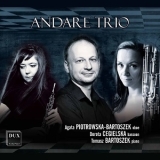In der klassischen Musik gibt es einige gebräuchliche Besetzungen in der Kammermusik wie Streichquartett und Bläserquintett. Die Besetzung Oboe, Fagott und Klavier ist nicht so geläufig. Drei polnische Musiker aus Lodz haben vier Werke für diese Besetzung eingespielt, die von ihrer Entstehungszeit ein Jahrhundert umspannen. Der Name André Previn dürfte dabei der bekannteste sein, der seinem Trio neoklassische Züge mit Anklängen an Jazz und populäre Musik gegeben hat. Einen außermusikalischen Hintergrund hat Daniel Baldwin in sein Trio Awotovi mit der Geschichte der gleichnamigen Siedlung der Ureinwohner der Hopi zum Thema hat.
Die drei in Lodz ausgebildeten Musiker sind diese vier Stücke mit Verve und Energie angegangen und haben so ein lebendiges Panorama geschaffen, dass mit dem frischen Zugriff unmittelbar überzeugt. Mag man sonst den Ton der Oboe mit näselndem Klang verbinden und das Fagott als dunkle Beimischung im Untergrund betrachten, so wird man hier eines Besseren belehrt. Nichts von beiden trifft zu. Die Oboistin, die in diesem Kontext die hohe Melodiestimme hat, überzeugt mit ebenso beschwingtem wie klarem Ansatz und prägt entsprechend ihrer Position die Werke. Die Stimme des Fagotts bildet natürlich schon das tiefe Register ab. Aber das bedeutet nicht, dass diese Linie farblos wäre. Vielmehr entfaltet die zweite Künstlerin des Trios behände Fähigkeiten, so dass diese Stimme eher mittanzt, als dass sie ein akustischer Klotz wäre, der die Entwicklung behindert. Der Pianist fügt sich als aufmerksamer Partner ein, indem er ebenso einfühlsam wie koordinierend die Klaviatur zu beherrschen weiß.
Neben den luftig fließenden schnellen Sätzen wissen die drei Partner auch den langsamen Sätzen ausdrucksvolle Formulierungen und Gestaltungen einzuhauchen und so auch diese Partien ihre Reize zu entlocken. So halten sie über die beinahe einstündige Einspielung die Spannung und bieten so für diese Besetzung äußerst reizvolle interpretatorische Lösungen an, die sich für die wiederholte Inohrenscheinnahme eignen.
In classical music, there are some common instrumentations in chamber music such as string quartet and wind quintet. The instrumentation of oboe, bassoon and piano is not so common. Three Polish musicians from Lodz have recorded four works for this instrumentation, spanning a century from their date of composition. The name of André Previn may be the best known, who has given his trio neoclassical traits with hints of jazz and popular music. Daniel Baldwin has brought an extra-musical background to his trio Awotovi with the history of the Hopi Native American settlement of the same name as its theme.
The three musicians, trained in Lodz, play these four pieces with verve and energy, creating a lively panorama that is immediately convincing with its fresh approach. One might otherwise associate the tone of the oboe with a nasal sound and regard the bassoon as a dark admixture in the background, but here one is disabused of this notion. Neither of these applies. The oboist, who has the high melody voice in this context, convinces with a performance that is as buoyant as it is clear, and she shapes the works according to her position. The bassoon’s voice, of course, represents the low register. But that does not mean that this line is colorless. Rather, the second artist of the trio nimbly unfolds skills so that this voice dances along rather than being an acoustic block that impedes development. The pianist inserts himself as an attentive partner, knowing how to control the keyboard with equal sensitivity and coordination.
In addition to the airy, flowing fast movements, the three partners also know how to breathe expressive formulations and shapes into the slow movements, thus also eliciting their charms from these parts. In this way, they maintain the tension throughout the almost hour-long recording and thus offer extremely appealing interpretive solutions for this instrumentation, which are suitable for repeated listening.
























